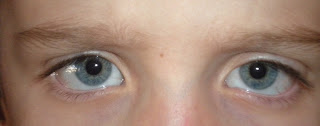Our son who is now 6 yo was diagnosed with ASD when he was 3. We've had a wonderful team of therapists and teachers. He is now a First Grader! We are a family of 4. Our little girl is 2 years old.
Friday, January 27, 2012
just another body part?
While nursing my baby girl, we look into each other’s eyes for a long time. As I’m gazing into her eyes I feel something, a kind of melting….. a kind of evaporating…
The eyes seem to gaze into the center of things...they can see into the beginning of you: where you start. If the right person looks at you too long you can feel so very exposed. The eyes are intimate and personal. Is this ingrained in our biology or in our psychology? Do we need this trait for intimacy and survival? And I ask myself what is it exactly about the eyes? Why couldn’t I look at her nose or her hair and get the same moving experience? The eye is just another body part, made of cells. Even though they often feel very deep, you really can’t see further than the retina. Perhaps it is the ability of seeing inside, literally, even if it is just a fraction. Beyond the surface of a human are the secrets waiting underneith.
One telling autistic trait is the aversion of eye contact. I believe it is even written in the DSM IV criteria for an autism diagnosis. A University of London team studied 104 six- to ten-month-old babies, 54 of whom were at elevated risk of developing autism because they had an older brother or sister on the spectrum. The researchers used a sensor cap placed on the scalp to register brain activity while the babies viewed dynamic images of faces that switchd from looking at them to looking away from them, or vice versa.
This experimental laboratory test showed that most infants who did not go on to develop autism showed clear differences in brain activity when viewing images of a face looking toward them versus one looking away. By contrast, infants who did go on to develop autism tended to show little difference in brain activity when viewing the two types of shifting gazes.
Studies have shown that the human brain displays characteristic patterns of activity in response to eye contact with another person. This response appears to be critical for face-to-face social interactions. Research has also shown that older children with autism have atypical patterns of eye contact as well as atypical brain responses when making eye contact. "Researchers studying infants at risk for ASD are now able to show differences in brain function as early as six months of age,” says Autism Speaks Director for Environmental Science Alycia Halladay, Ph.D. -see footnote
In one of the books I have read written by someone living with autism the author couldn’t get over how us “neurotypicals” are so obsessed with eye contact. They described it as “just another body part” We ARE obsessed with eye contact, right? We have the expression “the eyes are the window to the soul”, which must sound utterly ridiculous to someone with autism. But there is something to it, because I can feel it. Why the eyes? What are they meant to do? Is their function beyond that of seeing things? If so, where does that leave people on the spectrum?
article exerpt from http://www.autismspeaks.org/science/science-news/infant-brain-activity-flags-autism-risk
Subscribe to:
Post Comments (Atom)



No comments:
Post a Comment